You are using an out of date browser. It may not display this or other websites correctly.
You should upgrade or use an alternative browser.
You should upgrade or use an alternative browser.
AlphaVictory Engine Build
- Thread starter IronHorse
- Start date

Help Support Home Model Engine Machinist Forum:
This site may earn a commission from merchant affiliate
links, including eBay, Amazon, and others.
- Joined
- Mar 3, 2008
- Messages
- 243
- Reaction score
- 20
Blake: The lathe is a Sieg X2 sold from Cummins Industrial Tools, They had the best price (299.00), but expenxive shipping (130.00). That was 4 years ago and I think the have gone thru some changes. Most people hate the colour, but I love it!
Chuck: I would really love to see this engine run too, but I cannot get it to run

 ??? :'( (lots of emotions here!)
??? :'( (lots of emotions here!)
I will post some pictures and results from the tests I am doing, but it does not look good. The piston fit is really nice and they slide smoothly and seal very good. There is tons of compression (maybe too much). I have tryed some alternate flywheels (some really large) but no luck. When it is cold, a flick of the flywheel will only spin 1/2 turn due to the compression. When I heat up the hot cylinder to high temps ( 1/3 of the side of the cylinder is red hot) It will spin for maybe 6 revolutions but showns no sign of wanting to run. With the pressure released from the cylinders a flick of the flywheel turns it over a dozen times at least.
All of the above results are with the cover off and the crankcase unsealed. The guys in Turkey have the crankcase sealed, but I saw a nice one on YouTube by GreenPower and he has a un-sealed crankcase. If I seal the crankcase it feels the same with the heat on or off.
The problem is there are not much I can adjust, on a IC engine you can play with the timming, ignition and fuel delivery, but on this thing everything is "fixed" in the design.
It was a risk to build this but I just had to try it. I should have got a hint after looking at a design guide and it had hundreads of pages of calculations. I will try to get it running for a while, but I am considering redesigning a few things to convert it to a Beta type Sterling.
Any segestions welcome.
IronHorse
Chuck: I would really love to see this engine run too, but I cannot get it to run
I will post some pictures and results from the tests I am doing, but it does not look good. The piston fit is really nice and they slide smoothly and seal very good. There is tons of compression (maybe too much). I have tryed some alternate flywheels (some really large) but no luck. When it is cold, a flick of the flywheel will only spin 1/2 turn due to the compression. When I heat up the hot cylinder to high temps ( 1/3 of the side of the cylinder is red hot) It will spin for maybe 6 revolutions but showns no sign of wanting to run. With the pressure released from the cylinders a flick of the flywheel turns it over a dozen times at least.
All of the above results are with the cover off and the crankcase unsealed. The guys in Turkey have the crankcase sealed, but I saw a nice one on YouTube by GreenPower and he has a un-sealed crankcase. If I seal the crankcase it feels the same with the heat on or off.
The problem is there are not much I can adjust, on a IC engine you can play with the timming, ignition and fuel delivery, but on this thing everything is "fixed" in the design.
It was a risk to build this but I just had to try it. I should have got a hint after looking at a design guide and it had hundreads of pages of calculations. I will try to get it running for a while, but I am considering redesigning a few things to convert it to a Beta type Sterling.
Any segestions welcome.
IronHorse
IronHorse
I'm certainly no expert on Stirling engines, but I have built a "tin can" stirling engine and have run it for hours trying different things. One thing I've noticed is that it takes several minutes of heat to get it going. Don't even try to spin it for a few minutes and see if that helps.
My early attempts to get it to run were unsuccessful and I put it to the side for about a year thinking it was a failure. A lot of other builders' engines were shown running on small candles and oil burners so that is what I started out with. Tried two even three candles and no luck. Tried a small outdoor oil lamp with a wick and again no luck. Spun it a million times...no luck. Tried adding a 10" saw blade to the flywheel...no luck. Tried a lighter flywheel and...no luck.
I decided to disconnect the connecting rod from the flywheel and manually stroked the walking beam on the displacer with heat applied to the displacer. The power piston stroked quite a bit further than my original design.
Lengthened the stroke to the max my engine would allow and it still didn't run without a little help.
Broke out the propane torch and built a little insulating/shielding system to trap the heat around the displacer firebox. To my surprise it ran and ran well. It just needed more heat. It actually has enough power to run with me dragging my finger on the flywheel. You can stall it out and it actually will run a little faster when you finally let go of it.
Point of all this talk is, the engine thrives on heat and lots of it. Adding cold water to the cooling side on mine slows it down until everything reaches some kind of heat equilibrium. When the water reaches 180°F it seems to run the best.
I know this goes against all of the theory on heat engines, but I think it points in my case to:
1. Inefficient heat transfer, or not enough heat applied
2. Too much of a cold sink, or too much heat being lost somewhere.
Hope this helps somehow.
Rich
I'm certainly no expert on Stirling engines, but I have built a "tin can" stirling engine and have run it for hours trying different things. One thing I've noticed is that it takes several minutes of heat to get it going. Don't even try to spin it for a few minutes and see if that helps.
My early attempts to get it to run were unsuccessful and I put it to the side for about a year thinking it was a failure. A lot of other builders' engines were shown running on small candles and oil burners so that is what I started out with. Tried two even three candles and no luck. Tried a small outdoor oil lamp with a wick and again no luck. Spun it a million times...no luck. Tried adding a 10" saw blade to the flywheel...no luck. Tried a lighter flywheel and...no luck.
I decided to disconnect the connecting rod from the flywheel and manually stroked the walking beam on the displacer with heat applied to the displacer. The power piston stroked quite a bit further than my original design.
Lengthened the stroke to the max my engine would allow and it still didn't run without a little help.
Broke out the propane torch and built a little insulating/shielding system to trap the heat around the displacer firebox. To my surprise it ran and ran well. It just needed more heat. It actually has enough power to run with me dragging my finger on the flywheel. You can stall it out and it actually will run a little faster when you finally let go of it.
Point of all this talk is, the engine thrives on heat and lots of it. Adding cold water to the cooling side on mine slows it down until everything reaches some kind of heat equilibrium. When the water reaches 180°F it seems to run the best.
I know this goes against all of the theory on heat engines, but I think it points in my case to:
1. Inefficient heat transfer, or not enough heat applied
2. Too much of a cold sink, or too much heat being lost somewhere.
Hope this helps somehow.
Rich
- Joined
- Mar 3, 2008
- Messages
- 243
- Reaction score
- 20
Rich: You are probably right about the need for heat, but since I silver soldered the pipe to the cylinder, I have to be careful how hot I get it. I do get a large area of the cylinder heat exchanger red hot. I think it may run if I could get the whole top half of it red hot. I think if it needed that much heat, my design has failed  I am going to try to spread out the heat some more by using two torches.
I am going to try to spread out the heat some more by using two torches.
Chuck: Here is the link to the video. It is a nice powerful runner, and notice that the crankcase is not sealed.
[ame]http://www.youtube.com/watch?v=5pdqDQwehlk[/ame]
IronHorse
Chuck: Here is the link to the video. It is a nice powerful runner, and notice that the crankcase is not sealed.
[ame]http://www.youtube.com/watch?v=5pdqDQwehlk[/ame]
IronHorse
IronHorse,
Did you have any success?
Try this link to a V twin Alpha running.
Rich
View attachment V-TWIN ALPHA watch.htm
Did you have any success?
Try this link to a V twin Alpha running.
Rich
View attachment V-TWIN ALPHA watch.htm
- Joined
- Mar 3, 2008
- Messages
- 243
- Reaction score
- 20
I have tried a few different things to get this engine to run. But I am have no luck so far. :'( I tried a few flywheels of various sizes, but that just made it spin longer doing nothing! Here is a picture of the largest experimental flywheel, also one of the ugliest I have ever made.
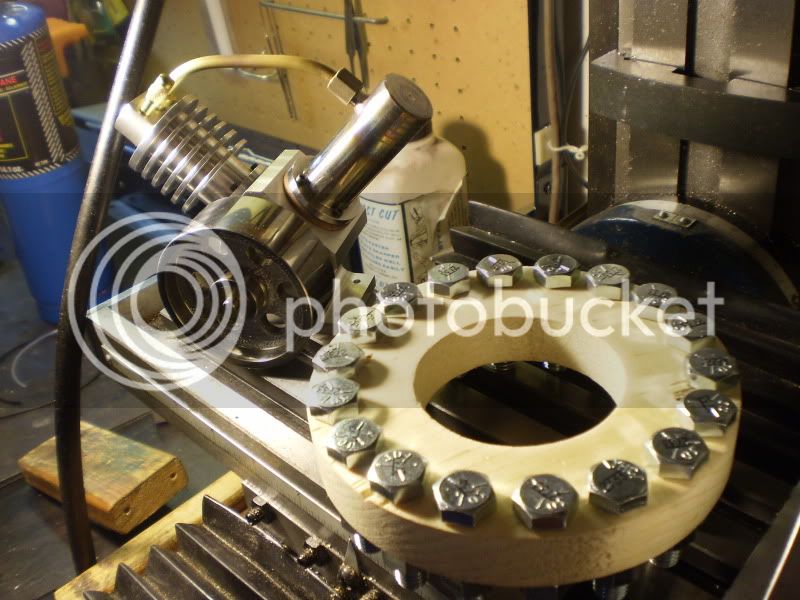
Another concern was the amount of heat needed to run this engine. In the following picture I am heating the tube up with 2 torches ( I had to put one down to grab the camera) This is the absolute hotest I can get the cylinder temperature up to before the silver solder melts! Clearly I am using as much energy as to cook my dinner and getting 0 Watts output, I think I will finally stamp this one as a Failure and move on to the next project. I may in the future convert this to a different mode of Sterling engine, but in the meantime it still looks good on my shelf.
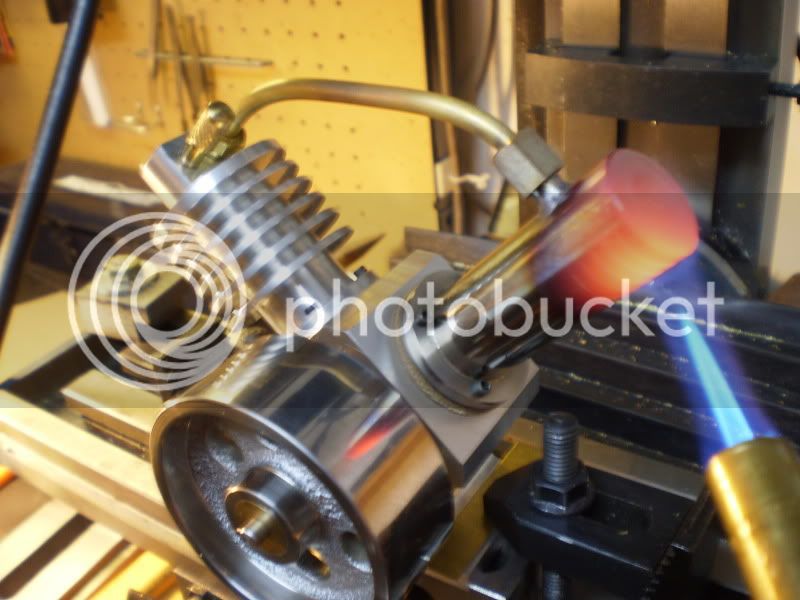
IronHorse

Another concern was the amount of heat needed to run this engine. In the following picture I am heating the tube up with 2 torches ( I had to put one down to grab the camera) This is the absolute hotest I can get the cylinder temperature up to before the silver solder melts! Clearly I am using as much energy as to cook my dinner and getting 0 Watts output, I think I will finally stamp this one as a Failure and move on to the next project. I may in the future convert this to a different mode of Sterling engine, but in the meantime it still looks good on my shelf.

IronHorse
- Joined
- Aug 25, 2007
- Messages
- 3,890
- Reaction score
- 715
I've studied the animation at the beginning of this thread and I have a couple of observations (OK, opinions).
1. The difference between your engine and all the other examples I've seen running is the displacer piston. Your engine uses a positive displacer which means that as the air is heated it is trying to push the displacer back down. The other engines use a loose displacer which allows the heated air to bypass it and act only on the power piston.
2. I think for the positive displacer idea to work, the air has to give up a lot of heat, perhaps through a regenerator, as it passes out of the heating chamber and into the power cylinder. I also think it requires some really tricky timing between the air heating/cooling cycle and the engine movement.
I'm wondering if blowing a jet of compressed air across the cooling fins of the power cylinder while heating the displacer cylinder would work?
Chuck
1. The difference between your engine and all the other examples I've seen running is the displacer piston. Your engine uses a positive displacer which means that as the air is heated it is trying to push the displacer back down. The other engines use a loose displacer which allows the heated air to bypass it and act only on the power piston.
2. I think for the positive displacer idea to work, the air has to give up a lot of heat, perhaps through a regenerator, as it passes out of the heating chamber and into the power cylinder. I also think it requires some really tricky timing between the air heating/cooling cycle and the engine movement.
I'm wondering if blowing a jet of compressed air across the cooling fins of the power cylinder while heating the displacer cylinder would work?
Chuck
I'm thinking of trying to build an alpha stirling, so I recalled your build thread, which I was following in June. Sorry to hear it's not running  My 2 cents: try replacing the connecting pipe between the cylinders with a fatter one and stuff it with metal wool to make a regenerator.
My 2 cents: try replacing the connecting pipe between the cylinders with a fatter one and stuff it with metal wool to make a regenerator.
All the best,
Rob
All the best,
Rob
- Joined
- Mar 3, 2008
- Messages
- 243
- Reaction score
- 20
I am going to take another stab at getting this engine to run. I have being reading up on Andy Ross's designs, especially his V15 engine. Mine is very similar to his, but it appears he is able to flow more air from cylinder to cylinder than I can. I am going to take Robertvi suggestion and cut off the connecting pipe and fabricate a new thicker one. I should have this done this weekend, and I am hoping to get it to run soon.
IronHorse
IronHorse
- Joined
- Mar 3, 2008
- Messages
- 243
- Reaction score
- 20
Well after the third modification this engine finally runs :big: I would not call it a great runner yet, but things are looking up. I finally made a re-generator like I had designed for originally. The re-generator is simply a copper tube, stuffed with copper scrub pad. One of the main purposes of this is to remove some of the heat before it enters the cool cylinder and to preheat the cold air as it returns to the hot cylinder. Sound pretty simple, but there have being few efficient designs of this type of engine in the last 200 years!
I am really happy that I finally got this engine to run. After all the design work and machining, it was disappointing that I could not get it to run.
Here is the new Re-generator
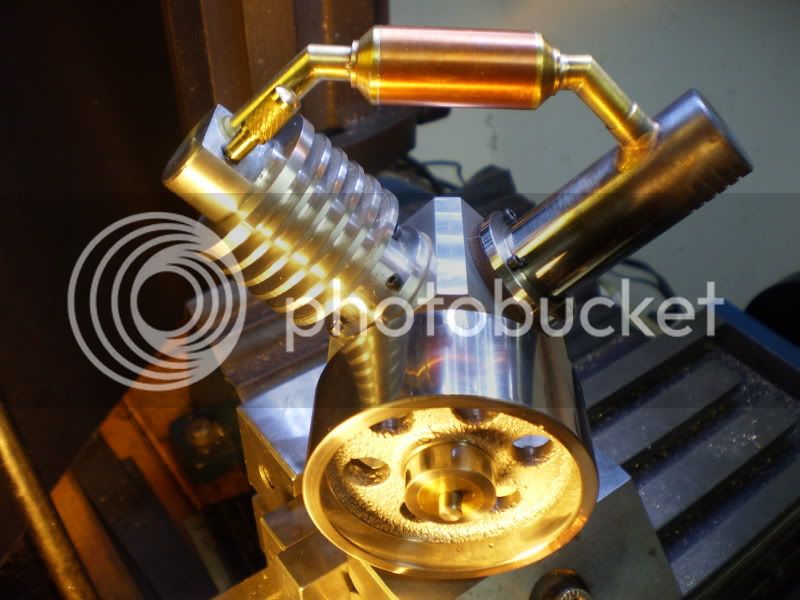
The scrub pad used for the Re generator
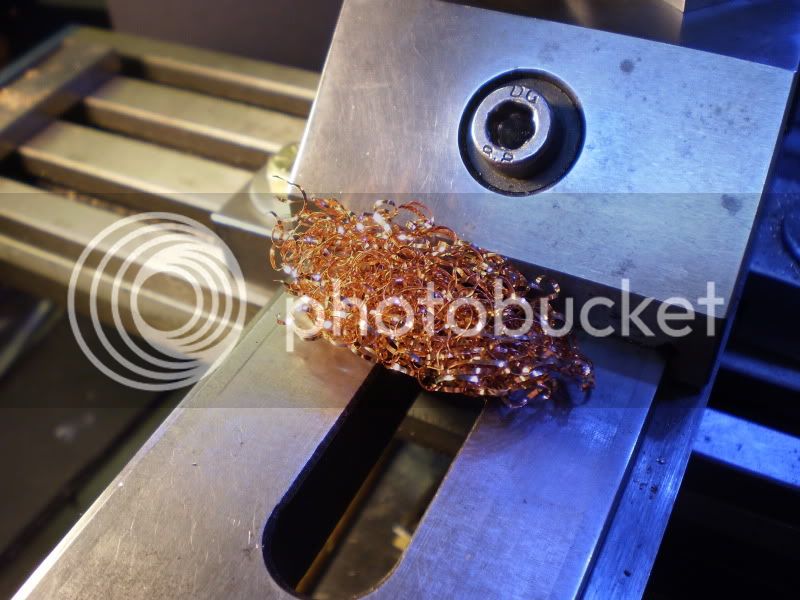
Finally, the engine running
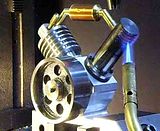
Thanks to Cfellows and robertvi for the suggestions.
IronHorse
I am really happy that I finally got this engine to run. After all the design work and machining, it was disappointing that I could not get it to run.
Here is the new Re-generator

The scrub pad used for the Re generator

Finally, the engine running

Thanks to Cfellows and robertvi for the suggestions.
IronHorse
Looks like it runs pretty well to me! Good looking engine, and quiet too.
By how quickly it came to a stop when you removed the heat, I wonder if you might
have a little excess friction going on.
Whatever the case, it certainly does run! Congrats.
Dean
By how quickly it came to a stop when you removed the heat, I wonder if you might
have a little excess friction going on.
Whatever the case, it certainly does run! Congrats.
Dean
- Joined
- Mar 3, 2008
- Messages
- 243
- Reaction score
- 20
Thanks for the comments.
I think it stops so fast after the flame is turned off, is because this engine has such a long stroke, the compression ratio is quite high. If you look at any of Andy Ross's engines the thing will run for minuit's after the flame is removed. I noticed he usually uses a short stroke on his engines. When I open the bled screw to remove the compression, the flywheel will spin easy.
As for drawings; I have learnt from doing this design that there are a few problems. First is that too much heat transfers thru the re-generator pipe. It should be farther from the heat source. Also I think the pipe could be a little larger. I think I will wait for an improved design before publishing any drawings.
IronHorse
I think it stops so fast after the flame is turned off, is because this engine has such a long stroke, the compression ratio is quite high. If you look at any of Andy Ross's engines the thing will run for minuit's after the flame is removed. I noticed he usually uses a short stroke on his engines. When I open the bled screw to remove the compression, the flywheel will spin easy.
As for drawings; I have learnt from doing this design that there are a few problems. First is that too much heat transfers thru the re-generator pipe. It should be farther from the heat source. Also I think the pipe could be a little larger. I think I will wait for an improved design before publishing any drawings.
IronHorse
A really beautiful engine and great success in getting it running too.
Don't know how but I have missed this thread up to now. Really interesting build thread with some really great and inspiring tips for new people like me.
Thanks for taking the time to share.
Don't know how but I have missed this thread up to now. Really interesting build thread with some really great and inspiring tips for new people like me.
Thanks for taking the time to share.
Similar threads
- Replies
- 27
- Views
- 3K
- Replies
- 6
- Views
- 781



